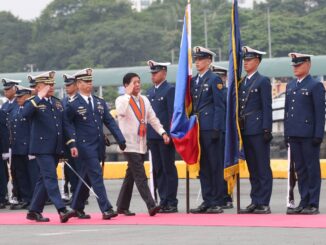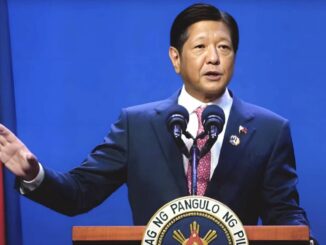
MANILA, Philippines — President Ferdinand Marcos Jr.’s third State of the Nation Address began with a by-the-book reinforcement of his technocratic image as an economic manager, then ended with his rousing pronouncements calling to protect the West Philippine Sea and ban all Philippine offshore gaming operators (POGOs).
Met with swelling applause, Marcos’ third SONA was expectedly free of personal digs to his former UniTeam allies and peppered with minutiae details of the economic, education, health and social programs to come.
Here, we break down the one-hour speech into easily digestible topics from A to Z.
Agriculture
Like last year, Marcos opened his speech with plans to galvanize the agricultural sector, starting with the provision of more seeds, fertilizers, livestock, boats and technical and financial assistance to farmers and fisherfolk.
The president said “the hard lesson” of the past year is that data showing the Philippines’ fair standing in the region “means nothing to a Filipino, who is confronted by the price of rice at P45 to 65 pesos kilo.”
The president served concurrently as Department of Agriculture secretary for 17 months before picking fishing tycoon and top campaign donor Francisco Laurel Jr. to replace him.
Business
Marcos noted a rise in the number of new businesses and corporate registrations, including foreign firms, driven by expedited processes for registration and approval.
To bolster economic growth, the president said his administration is pushing for an investment-friendly environment through capital market reforms and the implementation of “green lanes,” which are streamlined processes designed to reduce bureaucratic hurdles for businesses.
Climate change
Known to speak in broad strokes about the climate crisis, President Marcos this time bannered the country’s proactive stance on global climate responsibility, including being the host country of the board of the Loss and Damage Fund, which seeks to help poor nations cope with costly climate disasters
The president also spoke of ongoing efforts to enhance disaster preparedness and promote renewable energy sources to mitigate the impact of climate change.
Digitalization
Marcos also claimed the government has made leaps and bounds in digitalization, noting that the number of common towers, or shared infrastructure that allow different telecommunications providers to have co-sharing arrangements, has more than tripled due to streamlined permitting processes.
E-visa
Marcos also highlighted improvements in air transport and tourism through the e-travel system, which provides a digital single data collection platform for passengers arriving in and departing from the Philippines.
The president said e-gates (electronic gates) will become “standard fixtures” in airports, while the “e-visa” is next on his government’s digital transformation agenda.
Free Wi-Fi
Marcos mentions another statistic: nearly ten million unique user devices have reportedly benefited from the government’s free Wi-Fi program, which provides internet access in over thirteen thousand locations across the Philippines, including schools and remote areas.
Marcos also announced the completion of phase 1 of the National Fiber Backbone, with phases 2 and 3 underway and expected to be completed by 2026, aimed at significantly boosting the country’s internet bandwidth capacity.
‘Generic’ medicine
Marcos announced that PhilHealth has significantly expanded its coverage of generic medicines for outpatient benefits, increasing the number of included generic drugs from 21 to 53. This expansion includes new medications for hypertension, nerve pain, and epileptic seizures.
Hospital decongestion
Marcos also bannered two new specialty hospitals that aims to decongest public hospitals and galvanize the “nation’s fight against cancer.” These are the UP-PGH Cancer Center, the first Public Private Partnership project to be approved under Marcos, and the the Philippine Cancer Center of the Department of Health, which broke ground in March.
Inflation
In relation to his plans for agriculture, Marcos listed several measures to reduce food prices and ultimately tame inflation, which at least 74% of Filipinos said the government is failing to manage in a Pulse Asia survey last week.
Due to “illegal price manipulations and smuggling,” Marcos said the government has temporarily set price ceilings on rice and reduced tariffs on rice, corn, and pork until the end of the year and assured the sector these were only “short-term solutions.”
Jobs
In describing his plan to create more jobs in the country, Marcos touted the estimated 202,000 jobs expected to be created from the investment pledges he scored while on his numerous trips abroad.
Another statistic: Marcos cited the Philippines’ increased employment rate 95.9% and decreased underemployment from 11.7% in May of 2023 to 9.9%.
‘Kadiwa’ expansion
Marcos said his pet KADIWA program was instrumental in helping people deal with high food prices.
He announced plans to expand the KADIWA centers with local government support, aiming to make them permanent and well-distributed across the country.
Law and order
After recently vetoing the proposed Philippine National Police Reform Act due to the absence of strong accountability standards for cops, Marcos reiterated the need for law enforcers to build public trust to maintain law and order.
“We have noted an overall decrease in crime rate and an improvement in crime-solution efficiency. But this is not enough. Our law enforcers need to earn the trust of our people,” Marcos said.
Mindanao-Visayas interconnection
Marcos also mentioned the 450-megawatt Mindanao-Visayas Interconnection Project of the National Grid Corp. of the Philippines, which was ceremonially switched on in January, as “a defining moment not only for the power sector but for the entire country.”
With the project, the president said the government has connected the power grids of all three major island groups of Luzon, Visayas and Mindanao.
National learning recovery
Aware of the Philippines’ flagging performance in international assessments, Marcos turned his focus on improving the conditions of teachers, who he described as the “core of our national learning recovery.”
Marcos hailed recent moves to provide teachers with an annual chalk allowance in the “Kabalikat sa Pagtuturo” Act and the provision of a personal accident insurance for teachers through the Government Service Insurance System.
“Our national learning recovery program must proceed without the slightest disruption, especially in basic education,” Marcos said.
Overseas Filipino workers
After expressing the usual gratitude to overseas Filipino workers for their remittances and their impact on the economy, Marcos said his government has provided “special facilities and services” for them: the OFW lounge at the Ninoy Aquino International Airport and the Seafarer’s Hub in Manila.
POGO ban
Triggering a standing ovation from administration supporters and critics alike, Marcos announced a total ban on all POGOs across the country and ordered the Philippine Amusement and Gaming Corp. (PAGCOR) to wind down their operations by the end of the year.
Marcos also ordered the Department of Labor and Employment to look for new jobs for Filipinos who will be affected by the ban.
In the past months, Sen. Sherwin Gatchalian and Sen. Risa Hontiveros have both uncovered a string of POGO-related crimes in the country that they say can also be traced back to the public officials who benefited from them, such as suspended Bamban Mayor Alice Guo, whose birth certificate and other claims of citizenship have been tagged as inauthentic.
Quality of life
Marcos also hailed the Pantawid Pamilyang Pilipino Program’s success in “breaking the cycle of poverty” in the Philippines with around 420,000 families who have graduated from the program.
The president also seeks to expand the 4Ps program to benefit pregnant women by capitalizing on the rare window for significantly improving children’s development and quality of life — from mother’s pregnancy to age 2.
‘Railway renaissance’
As part of his ambitious Build Better More infrastructure program, Marcos described an ongoing “railway renaissance” in the country of building more railways to improve public transportation.
He cited as an example the Metro Manila Subway Project, where tunneling works have reached depths equivalent to three to six floors. He also noted that other railway projects, including MRT-7 and the North-South Commuter Railway, are making steady progress.
Space technology
Marcos also praised the achievements of Filipino space scientists and engineers for reaching new heights in the pioneering field. Since the nation’s foray into space technology, the country’s satellites in space have generated more than 51,000 maps, images and space-borne data, the president said.
Marcos noted that 16 Filipino space engineers are currently in the United Kingdom working on the MULA satellite, which, once completed, will be the country’s largest Earth observation satellite to date.
Tech-voc training
Besides listing his usual expectations for the government’s biggest education agency — the Department of Education — Marcos this time expressed hopes for the much smaller Technical Education And Skills Development Authority to step up its programs to produce more employable graduates.
“Statistics do not lie. Eight out of ten graduates of TVET ultimately land decent jobs. So with its high employability rate, TVET will definitely be instrumental in capacitating our people, and in maintaining our employment rate at consistently high levels,” the president said.
University rankings
The number of Philippine universities that make it to world rankings appears to be a continuing marker of success for the Marcos administration.
Marcos said this year, 87 higher education institutions (HEIs) have now made it into various world university rankings, 51 of which are public universities or colleges.
Vaccination
As part of the administration’s recalibrated approch towards prevention, Marcos said that they would prioritize vaccinations.
The government will continue vaccination efforts, especially for infants and children, particularly in Region 6 and BARMM, where less than half have been vaccinated.
Water security
Marcos laid down his strategy for ensuring water security: by completing irrigation dams to supplement other bulk water projects, especially in underserved areas.
Marcos cited the Jalaur River Multipurpose Project in Iloilo as an example of his water security programs, which is expected to irrigate nearly 32,000 hectares and also help in flood control, electricity generation, and tourism.
The damage wrought by El Niño to farmers has led the government to shell out over P9 billion in crop insurance payments and explore early adoption of modern low-water-use farming technologies, the president added.
X-periental tourism
To boost the Philippines’ tourism standing in the region, Marcos is eyeing to focus on what the country can offer in terms of experiential tourism, which seeks to provide travelers with the opportunity to immerse themselves in the destination country’s culture and history.
The president’s vision for the tourism industry is in line with the Department of Tourism’s findings last year when its market survey showed that post-pandemic, travelers would rather spend their money on experiences and not on material things.
Youth creativity
Marcos also wants the nation’s youth to not just be literate but also capable of creative and innovative thought.
Ideally, the president said the education system must also “consciously develop them into problem-solvers, and into critical thinkers — hungry for success [and] ready for the future.”
According to the results of a new Programme for International Student Assessment (PISA) global test released in June, the Philippines ranks in the bottom four among 64 economies in terms of creative thinking.
‘Zones’
The proposed Maritime Zones Act — a priority measure that a bicameral conference committee has already approved — was spotlighted as one of two pending legislations needed for Filipinos to continue their “intergenerational mandate” of defending the country’s sovereign rights West Philippine Sea.
The measure defines the maritime zones under the country’s jurisdiction to fend off entities that seek to challenge the 2016 ruling, which dismissed China’s claim of historic rights over almost the entire South China Sea, including parts of the West Philippine Sea.





Be the first to comment